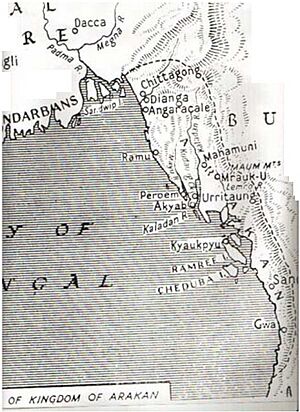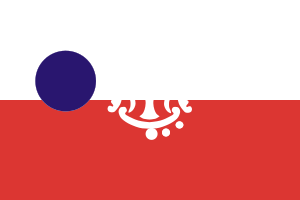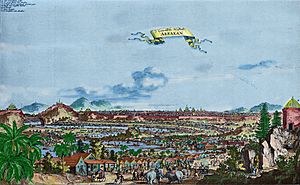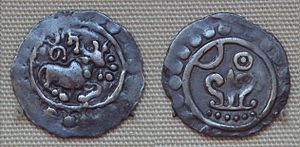History of Rakhine facts for kids
Rakhine State is a coastal region in Myanmar, located along the border with Bangladesh. This area was once home to the ancient Kingdom of Arakan. The history of Rakhine can be divided into several important periods:
- The independent kingdoms of Dhanyawadi, Waithali, and Lemro.
- The powerful Kingdom of Mrauk U.
- A period of Burmese rule from 1785 to 1826.
- British rule from 1826 to 1948.
- Its time as part of independent Burma (now Myanmar) from 1948 onwards.
The Arakanese kingdom was taken over by the Burmese Konbaung dynasty on December 31, 1784. Later, in 1826, Arakan was given to the British after the First Anglo-Burmese War. It became part of British India in 1886 when Burma was fully annexed by the British. In 1937, Arakan became part of the Crown Colony of British Burma, which separated from British India. During the Japanese occupation of Burma in World War II, northern Rakhine state became a contested area. After 1948, Rakhine became part of the newly independent country of Burma. In 1973, Arakan was officially made a state within the Socialist Republic of the Union of Burma, recognized as the home of the Rakhine people.
Throughout its history, Rakhine has experienced periods of tension between different communities, especially between the Buddhist Arakanese and Muslim groups. These challenges have led to various difficulties over time.
Contents
Ancient Kingdoms of Rakhine
Dhanyawadi Kingdom
Arakanese stories say that their history began in Rakhine a very long time ago. However, the earliest solid evidence shows a civilization forming around the 4th century AD. The Rakhine people, who are the main group today, are from a Tibeto-Burman background and arrived in Arakan around the 10th century. Ancient Arakanese kingdoms sometimes stretched from the Ganges Delta to Cape Negrais on the Irrawaddy Delta.
The ancient city of Dhanyawadi was located west of a mountain range, between the Kaladan and Le-mro rivers. You could reach Dhanyawadi by small boat from the Kaladan river. Its city walls were made of brick and formed a large circle, about 9.6 kilometers (6 miles) around. Inside, there was an area of about 4.42 square kilometers (1,092 acres). Outside the walls, you can still see parts of a wide moat, which is now filled with silt and covered by rice fields. Brick defenses also protected the city from the west along a hilly ridge.
Inside the city, another wall and moat surrounded the palace area, which was about 26 hectares (64 acres). This inner wall also protected the palace itself. During times of danger, like raids from hill tribes or attempted invasions, the city had enough food stored to survive a siege. The city controlled the valley and lower hills, where people grew wet-rice and used taungya (slash and burn) farming. Local chiefs paid respect to the king.
From aerial photos, we can see Dhanyawadi's old irrigation channels and water storage tanks, which were centered around the palace. Throughout Rakhine's history, and in early Southeast Asia, the king's power often came from controlling irrigation and water systems. These systems helped save monsoon rains, making the land fertile and prosperous. In ceremonies led by Indian Brahmins, the king was believed to gain special powers to control the weather, ensuring good rains and the kingdom's success.
Waithali Kingdom
It's believed that the main center of power in Arakan shifted from Dhanyawadi to Waithali in the 4th century AD, after the Dhanyawadi Kingdom ended around 370 AD. Waithali was more influenced by Indian culture than the other Arakanese kingdoms. Like all Arakanese kingdoms, Waithali thrived on trade between the East (like the Pyu city-states, China, and the Mons) and the West (India, Bengal, and Persia). The kingdom became rich from maritime trade routes between China and India. Waithali was a famous trading port, with thousands of ships visiting each year during its peak. The city was built on the banks of a tidal creek and was surrounded by brick walls. The city's design showed strong Hindu and Indian influences.
According to the Anandachandra Inscription, carved in 729 AD, the people of the Waithali Kingdom practiced Mahayana Buddhism. The inscription also states that the ruling family of the kingdom were descendants of the Hindu god, Shiva. Dr. E. H. Johnston's study found a list of kings, starting with a king named Bahubali, which he believed was accurate. The inscription on the western side has 72 lines of text in 51 verses, describing Anandachandra's ancestors. Each side listed the name and ruling period of kings who were thought to have ruled the land before Anandachandra. The Sanskrit text of this inscription is unique in Myanmar, as Sanskrit was not widely used outside Arakan. The inscription also hints at political and religious connections with Sri Lanka and Andhra.
The first ruler of the Waithali Kingdom was Bahubali. Many years after his reign, a dynasty called Annaveta was established in Waithali. They were followed by another dynasty that ruled until 370 AD. In 370 AD, the last ruler of this dynasty, named Lanki, was defeated by a chieftain named Dvenchandra (also known as Mahataing Chandra). Dvenchandra then started the Chandra dynasty, named after the god Chandra who appeared on Waithali coins. The Waithali period is considered the beginning of Arakanese coinage, which started almost a thousand years before Burmese coinage. On one side of the coins, you can see the Srivatsa (Thiriwutsa) symbol, while the other side shows a bull, which was the symbol of the Chandra dynasty. The king's name was written in Sanskrit below the bull. The designs on the coins were based on Brahmanical traditions and included bells, flowers, and the trishula (a trident). The art style of these coins is similar to the Gupta art style. Similar coin designs were also found in nearby areas like Chittagong, Dvaravati, and Champa from the late 1st millennium.
There is some debate among historians about the last ruler of the Chandra dynasty. Some believe the last king was Dharmasura, who was defeated by a chieftain named Vajrasakti. Vajrasakti then established the Dharmaraja-andaja dynasty (also called Dev-andaja or Deva dynasty). Anandachandra, the king who created the famous inscription, was Vajrasakti's grandson. Other historians think that the last four rulers mentioned in the Anandachandra Inscription, including Anandachandra himself, actually belonged to the Chandra dynasty.
Some important but damaged life-size Buddha statues were found at Letkhat-Taung, a hill east of the old palace. These statues are very helpful for understanding Waithalian architecture and how much Hindu influence there was in the kingdom.
According to local stories, Shwe-taung-gyi (meaning "Great Golden Hill"), a hill north-east of the palace, might be the burial place of a 10th-century Pyu king.
The Waithali Kingdom eventually declined in the 10th century. At the same time, Rakhine's political center moved to the Le-mro valley states, and the Bagan Kingdom began to rise in central Myanmar. Some historians believe the decline was due to a takeover or the arrival of the Mranma (Bamar people) in the 10th century.
Le-Mro Valley States
In the Rakhine language, "Le-Mro" means "four cities." This refers to four ancient Rakhine cities that grew along the Lemro River. Today, only some remains of these cities can be found along the Lemro River. One of the most famous kings who ruled during this period was King Min Hti, who reigned from 1279 to 1385.
Mrauk U Kingdom
Today, Mrauk U might seem like a quiet village, but not long ago, it was the bustling capital of the Arakan empire. Here, traders from Portugal, the Netherlands, and France met with scholars from Bengal and even Mughal princes who were on the run. Mrauk U was declared the capital of the Arakanese kingdom in 1430. At its strongest, Mrauk U controlled half of Bangladesh, modern-day Rakhine State (Arakan), and the western part of Lower Burma. As the city grew, many pagodas and temples were built. The ones that still stand today are the main attractions of Mrauk U. From the 15th to the 18th centuries, Mrauk U was the capital of a powerful Arakan kingdom. Foreign traders, including the Portuguese and Dutch, often visited, which is reflected in the grand and widespread structures found around the area.
The old capital of Rakhine (Arakan) was first built by King Min Saw Mon in the 15th century and remained the capital for 355 years. The golden city of Mrauk U became known in Europe as a place of amazing oriental splendor after Friar Sebastian Manrique visited the area in the early 17th century. Father Manrique's lively descriptions of King Thiri Thudhamma's coronation in 1635, and his stories about the Rakhine Court and the schemes of Portuguese adventurers, captured the imagination of later writers. The English author Maurice Collis made Mrauk U and Rakhine famous with his book, The Land of the Great Image, which was based on Friar Manrique's travels in Arakan.
The Mahamuni Buddha Image, which is now in Mandalay, was cast and worshipped 15 miles from Mrauk U. Another Mahamuni Buddha Image, flanked by two other Buddha images, is still there. You can easily reach Mrauk U from Sittwe, the capital of Rakhine State. There are daily flights from Yangon to Sittwe, and small private boats as well as larger public boats travel along the Kaladan river to Mrauk U. It is only 45 miles from Sittwe and the seacoast. To the east of the old city is the famous Kispanadi stream, and further away is the Lemro river. The city area used to have a network of canals. Mrauk U has a small archaeological Museum near the Palace site, right in the center of town. As an important capital, Mrauk U was carefully built in a strategic location by leveling three small hills. The pagodas are placed strategically on hilltops and served as fortresses; they were indeed used as such during enemy invasions. There are moats, artificial lakes, and canals, and the entire area could be flooded to stop or push back attackers. There are countless pagodas and Buddha images around the old city and the surrounding hills. While some are still used as places of worship today, others are in ruins, and some are now being restored to their original beauty.
The city eventually grew to a population of 160,000 in the early 17th century. Mrauk U served as the capital of the Mrauk U kingdom and its 49 kings until the kingdom was conquered by the Burmese Konbaung dynasty in 1784.
Trading City
Because it was close to the Bay of Bengal, Mrauk U became an important regional trade center. It served as both a "back door" to the Burmese inland and a key port along the eastern shore of the Bay of Bengal. It became a stopping point for goods like rice, ivory, elephants, tree sap, and deer hide from Ava in Burma. It also traded cotton, slaves, horses, cowrie shells, spices, and textiles from Bengal, India, Persia, and Arabia. Along with Pegu and later Syriam, it was one of the most important ports in Burma until the 18th century.
The city also traded with non-Asian powers like Portugal and then the VOC from the Netherlands. The VOC started trading with the Arakanese in 1608. This happened after the Portuguese lost favor because their mercenaries, like Filipe de Brito e Nicote, were not loyal to the Arakanese king. The VOC set up a permanent trading post in Mrauk U in 1635 and operated in Arakan until 1665.
At its peak, Mrauk U was the center of a kingdom that stretched from the shores of the Ganges river to the western parts of the Ayeyarwady River. According to popular Arakanese stories, there were 12 'cities of the Ganges' around the borders of present-day Bangladesh that were governed by Mrauk U, including areas in the Chittagong Division. During that time, its kings made coins with inscriptions in Arakanese, Arabic, and Bengali.
Much of Mrauk U's history comes from the writings of Friar Sebastian Manrique, a Portuguese Augustinian friar who lived in Mrauk U from 1630 to 1635.
Colonial Period
The people of Rakhine continued to resist the conquest of their kingdom for decades afterward. Fighting with the Rakhine resistance, first led by Nga Than Dè and later by Chin Byan in border areas, caused problems between British India and Burma. In 1826, the Bamar were defeated in the First Anglo-Burmese War, and Rakhine was given to Britain under the Treaty of Yandabo. Sittwe (Akyab) was then chosen as the new capital of Rakhine. In 1852, Rakhine was combined with Lower Burma as a territorial division.
During the Second World War, Rakhine (Arakan) was given some self-rule under the Japanese occupation and even had its own army called the Arakan Defence Force. However, the Arakan Defence Force later joined the Allies and fought against the Japanese in early 1945.
Independent Burma
When Burma gained independence in 1948, Rakhine (Arakan) became a division within the Union of Burma. Soon after, challenges arose between Buddhist and Muslim communities. Later, there were calls for Rakhine (Arakan) to become separate, but these attempts were stopped. In 1974, the Ne Win government's new constitution changed Rakhine (Arakan) Division into a Union state. In 1989, the military government changed the name of Arakan State to "Rakhine."
Historical Artifacts
The oldest artifact found is a stone image of a Fat Monk with an inscription in Brahmi script that dates back to the first century AD.
An ancient stone inscription in Nagari script was found by archaeologist Forchhammer. This was on a hill known as Salagiri, where a great teacher was said to have come to Rakhine about 2500 years ago. From the eastern part of this hill, a stone image in Dhamma-cakra-mudra (a Buddha pose) was found in 1923 and is now kept in the Mrauk-U museum. This carving found on Salagiri Hill represents the Bengali Hindu king Chandra Suriya and dates to the 4th century CE. Five more red sandstone slabs with carvings were found near the south of Salagiri Hill in 1986. They are similar to the single slab found earlier. These carved slabs show different Buddha poses like Bhumispara-mudra, Kararuna-mudra, Dhammacakra-mudara, and Mahaparinibbana-mudra, representing events from the Buddha's life.
These sculptures provide the earliest evidence that Buddhism arrived in Rakhine during the Buddha's lifetime. These discoveries were believed to be figures of King Chandra Suriya of Dyanawadi, who dedicated the Great Maha Muni Image. Scholars have studied these archaeological findings and concluded that the Maha Muni was made during King Sanda Suriya's time.
The founder of Vesali city, King Dvan Chandra, carved the Vesali Paragri Buddha-image in AD 327 and added a dedication in Pali verse: "Of these dhammas which arise from causes / The Tathagata has declared causes / Lord Buddha preached about the causes / And the effects gained by the causes / And that which is the ceasing of them, Nirawda Thitesa / This the great ascetic declares."
This verse, which is considered the core of Theravada Buddhism, shows that Buddhism was very strong in Vesali. Vesali's connections with foreign countries, especially Ceylon (Sri Lanka), would have been established through Buddhism.
The Anandachandra Inscription, dating back to 729 AD and originally from Vesali, is now kept at Shitethaung. It provides clear evidence for the early establishment of Buddhism. Dr. E. H. Johnston's study revealed a list of kings, starting from the Chandra dynasty, which he considered reliable. The western side of the inscription has 72 lines of text in 51 verses, describing Anandachandra's ancestors. Each side recorded the name and ruling period of each king who was believed to have ruled the land before Anandachandra. Archaeology has shown that many stone pagodas and inscriptions, which were neglected for centuries in different parts of Rakhine, indicate that Buddhism was widely popular.
Cubic stone inscriptions record the peace agreement between the governor of Thandaway (Sandoway), Mong Khari (1433–1459), and Razadhiraj, the Mon Emperor. This inscription was found on a garrison hill at the oldest site of Parein. A stone slab with a figure believed to be the Hindu Bengali King Chandra Suriya supports the Salagiri tradition, which tells of the Teacher's arrival in Dyanyawaddy.
See also
- List of Arakanese monarchs
- Pyu city states
- Rakhine people
- Rakhine State





